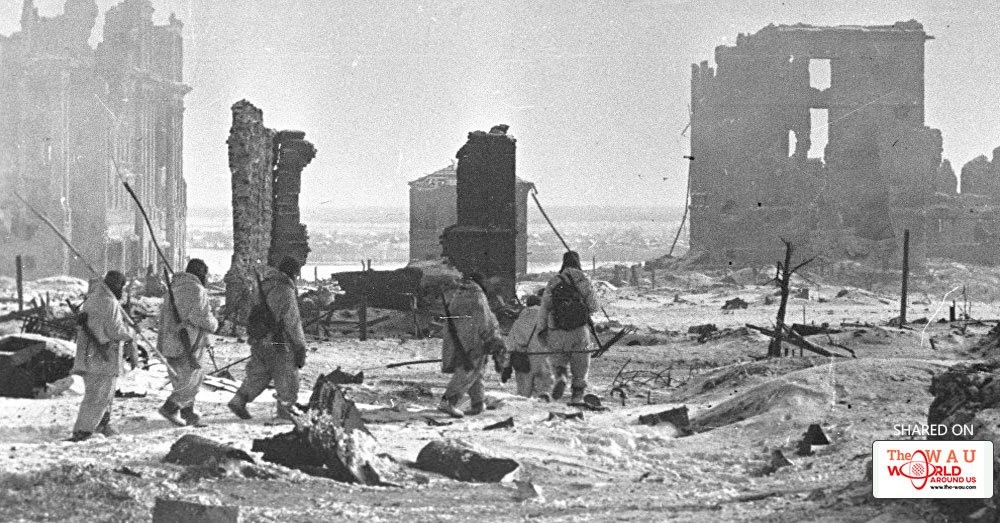75 years ago, Stalingrad, the Soviet industrial city on the Volga River, was subjected to its first aerial bombardment by the Luftwaffe, an event remembered in Russian historiography as one of the largest massed bombings in the history of the Great Patriotic War. RIA Novosti military observer Andrei Kotz pays tribute to the city and its defenders.
Andrei Kotz — 75 years ago, on August 23, 1942, Stalingrad was subjected to its first massed aerial bombardment, which literally leveled the city with the ground. Luftflotte 4, the Luftwaffe's fourth air fleet, hit the city with all its strength, and in half a day's time had destroyed over half of its housing stock.
After dropping heavy explosive bombs, which demolished buildings down to the foundation, the Luftwaffe began dropping incendiary bombs, which resulted in a plethora of fires across the city. A great vortex of fire devastated the city's center, and spread to its outskirts. This city, flourishing before the war, came to look like a plowed field, mixed with the skeletal outlines of the chimneys of ruined buildings.
Over 40,000 people were killed in the bombing. It seemed as though the city, destroyed by fire and smoke, would not be able to resist any longer. But bombing on August 23 would be only the beginning of the heroic defense of Stalingrad by Soviet troops, which lasted over six months.
Fiery Hell
By the time the bombing began, about one quarter of Stalingrad's 400,000 residents had been evacuated. Most of the remaining adults and children were involved in building fortifications – setting up barricades, digging trenches and anti-tank ditches, and camouflaging strategically important objects.
Preparing Stalingrad for a long siege was done under pressure, with the Wehrmacht quickly closing in. At 4 pm on August 23, a 6th German Army's shock group broke through to the Volga near the city's northern outskirts, outside the settlements of Latoshinka, akatovka, and Rynok. Anti-aircraft batteries of the 1077th Regiment of the Red Army were the first to come into contact with the armored vehicles of the 14th Panzer Corps. A fierce battle ensued.
Several hours later, the heavy bass sound of hundreds of bombers was heard over the city. Wave after wave of Junkers and Heinkels attacked, 30-40 planes at a time. The first bombs hit Stalingrad at about 6 pm in the evening. According to eyewitnesses, the earth literally shook. Powerful explosions were heard at intervals between 10-30 seconds, and the roar was such that nothing else could be heard.

"What happened to us on August 23 in Stalingrad struck like a terrible nightmare," Marshal Andrei Andrei Yeremenko recalled in his memoirs after the war.
"Without interruption, from one location to another, the fire-breathing sultans of bomb explosions soared upwards. Huge pillars of flames rose into the sky at the oil depot terminal. Streams of burning oil and gasoline rushed into the Volga. The river burned; steamboats burned in the harbor. The asphalt of streets and squares emitted noxious fumes. Telegraph poles lit up like match sticks. There was an unimaginable noise, deafening one with its infernal music. The shriek of bombs descending from the air mixed with the roar of explosions, the groaning and clatter of falling buildings, the crackling of the raging fires. The dying groaned in pain. Women and children cried uncontrollably and called for help," the commander wrote.
In a single day, the enemy carried out about two thousand sorties. The attack involved about a thousand aircraft of various types. The planes engaged in massed carpet bombing, rather than focusing on individual targets. Luftwaffe pilots had one mission – to wipe the city off the face of the earth. They more than succeeded. By the end of the day, the bulk of Stalingrad lay in ruins.
According to historians, on August 23 alone, between 40,000 and 90,000 people were killed. About 50,000 were injured. 309 city enterprises were destroyed. Factories including the Red October, the Stalingrad Tractor Plant, and the Barricades factory lost most of their shops and equipment. Transport and communications infrastructure was destroyed. The situation was aggravated by the fact that raging fires were practically impossible to put out – the city's water pipeline was put out of commission by the bombing.

Strategy of Terror
Of course, Stalingrad resisted the air attack. On August 23, Soviet aviation and antiaircraft guns destroyed between 90 and 120 German planes. However, soon after the bombing began, the city was covered with a solid screen of smoke, making aiming from the ground very difficult. Things were complicated by the fact that anti-aircraft gunners from the 1077th regiment were forbidden from shooting at aircraft, focusing instead on holding back the German tanks on the northern outskirts of the city. In conditions of a lack of anti-tank weapons, heavy anti-aircraft guns struck at enemy armor from their 37 guns.
A widely-known incident involving these units saw two tanks and three armor-clad tractors coming directly from the Tractor Factory to assist, supported by a battalion of workers with Mosin rifles. No other forces were present in the city. Formations of the 62nd Army continued to hold the enemy several dozen kilometers from Stalingrad on the left bank of the Don River.
This handful of defenders managed to hold back the enemy onslaught. The Germans failed to break through the city's northern defensive line, both on August 23 and in the following days. Wehrmacht General Gustav Anton von Wietersheim, commander of the
Thus, the Germans' main goal for the bombing – to crush the resistance of the Soviet troops defending the city, and the subsequent assault on Stalingrad by land units, failed. Many historians say that the Wehrmacht was not able to take advantage of the results of the Luftwaffe's efforts. As a result, the bombing came to look less like a military operation, and more like an act of terror. The German forces' fierce bombing of civilian transport evacuating the city can be similarly characterized.
"The evacuation of people from the left bank of the Volga was conducted by vessels of the Stalingrad River Fleet and the Volga Military Flotilla. On August 23-24, after all the piers were destroyed by air attack, the flotilla organized crossing by small boats," military historian Alexei Isaev wrote in his book 'Stalingrad: No Land Beyond the Volga'.
"This stage of the evacuation took place under attacks from the air and even from enemy artillery units. The Borodino steamer, with 700 wounded onboard, was hit by direct fire in the Rynok area and sank; only about 300 people were saved. The same fate befell the Joseph Stalin steamer, filled with about 1,200 evacuees, of whom only about 150 people survived," the historian added.
Nevertheless, having withstood the first and most terrible airstrike, Stalingrad's defenders managed to prepare for defense. Reinforcements were able to break through, and militiamen and civilians turned the ruins of their houses into a network of fortresses and fire points. When the Germans broke through into the city for the first time on September 14, 1942, they were given a 'warm welcome'.
The severely wounded city of Stalingrad took its revenge on those who had assailed it in a sustained and unswerving fashion until February 2, 1943, emerging in history as a symbol of the heroic resistance of the Soviet people and the grave of nearly a million German soldiers. The phrase of one of them, written in a diary, became known across the world: "Only one kilometer separates us from the Volga. But we cannot break through to it. We've been fighting for this one kilometer longer than we did for the whole of France, but the Russians stand like blocks of stone."
Share This Post












